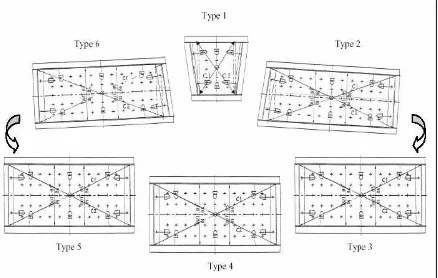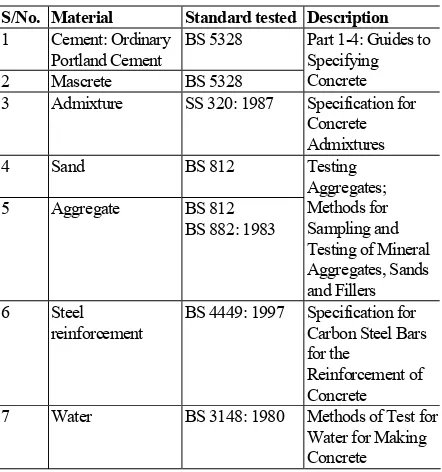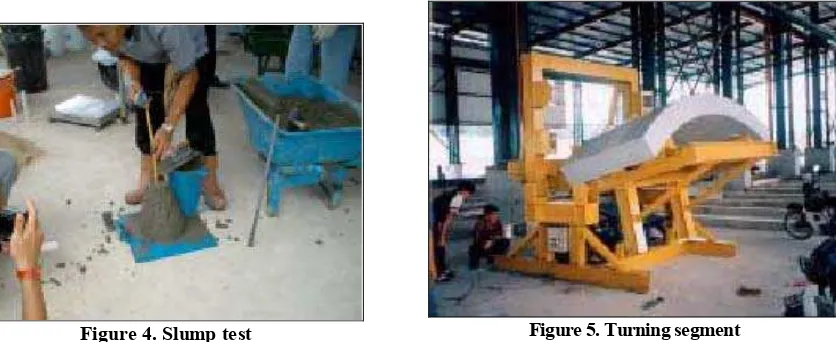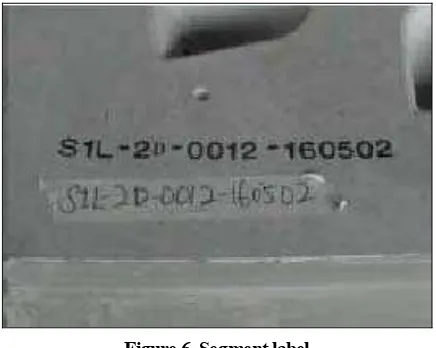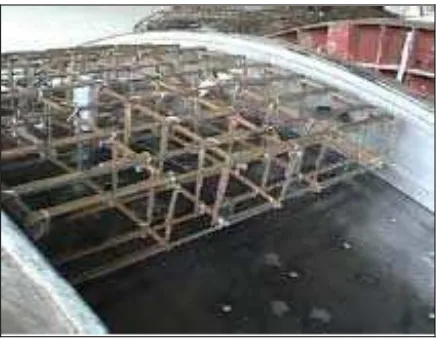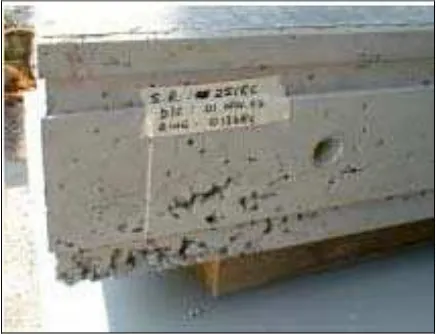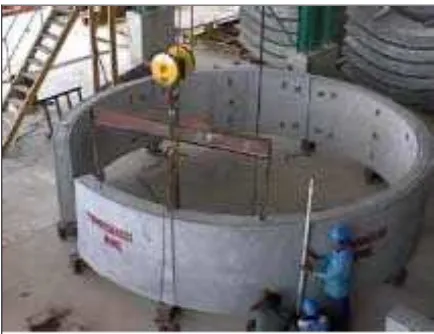QUALITY CONTROL IN PRECAST PRODUCTION
A case study on Tunnel Segment Manufacture
Agus Dwi Hariyanto
Lecturer Faculty of Civil and Planning Engineering, Architecture Department, Petra Christian University
Hon Pui Kwan, Yee Weng Cheong
Alumnt, Department of Building, National University of Singapore
ABSTRACT
Quality control forms an integral part of precast production. An efficient quality system is most critical in the mass production of precast components in any project. In this study, the quality control system implemented in a precast factory is discussed. The precast factory is set up for the manufacture of large quantity of tunnel segments under a contract. Processes in the precast manufacture are discussed with respect to the control procedures in the quality inspection plan. The standard tests involved, roles of inspectors and corrective actions on-site are highlighted. Critical issues pertaining to the productivity and quality of precast production are reviewed. These include the quality of staff and maintenance, which could potentially affect the efficiency of the quality system. Some considerations should also be given to improve the workflow and productivity of the plant.
Keywords: precast, quality control.
INTRODUCTION
Merits of Precast
The very existence of a precast concrete industry and the numerous successful building projects achieved using precast concrete, for the whole or just a part of the structure, is proof that the technique is practical and economical (Elliott, 2002). Structures with a high degree of modular coor-dination and repetitive grids are ideal for precast construction. Precast construction allows mass production. Better methods can be adopted in factories leading to speedy production and economic of scale. The advantages in productivity and lower unit price make precast construction welcomed in many recent projects. As precast modules are made under controlled conditions with close supervision, there can be a higher level of consistency, accuracy and quality. In addition, unique shapes and designs as well as various finishing effects can be achieved. Precast construction always groups similar work tasks for batch processing so that there is less material wastage as compared to conventional insitu construction methods. Since major fabricating pro-cesses are carried out off-site in precast construction, there is less wet trade in the construction area. The site can be neater and tidier, which is easier for site planning and space management. Reduction in site work also minimizes weather influence on the construction schedule. As a result, savings in construction time, manpower resources and a safer working environment can be achieved.
Practical Limitations
key for the success of construction projects. There is no exception in precast construction. While every measure is taken to ensure good quality product at the upstream of prefabrication, the reliability of precast depends a lot on the skillfulness of workers carrying out the installation tasks. Although tolerance is established during the design process, close supervision should be executed in joint detailing, connection methods and water penetration preven-tion during the installapreven-tion of precast components.
Quality Assurance & Control (QA/QC)
Quality control measures precast products’ characteristics and ensures they bear on the ability to satisfy the client’s needs and requirements (Warsza-wski, 1999). The quality level can be measured in terms of performance in health and safety, serviceability, aesthetic, etc. Usually the client’s requirements are stated clearly in method statements in the contract specifications. The objective of a QA/QC system is to maximize predictability and consistency of quality of precast components so as to ensure they are up to a required standard. There are some guidelines in codes and standards for users, designers and producers to determine their desired level of quality. These include direct performance, aesthetic, technological and economic considerations. The impact of possible cracks, deflections, and size deviations on the strength, durability, serviceability, and maintainability of the components are covered in the first consideration. The various defects and blemish that will affect the building’s appearance is included in the second consideration. The precision levels that can be expected from the equipment for batching, moulding and other production operations are covered in the third consideration. The last consist of the cost of equipment, materials, skilled labor, and inspection. While manufacturing precast components, a full record of concrete mix proportions, appearance and consistency of the mix results, as well as other pertinent factors like ambient temperature, humidity and timing of operation including mixing, handling, placing and curing should be maintained (Richardson 1991). Before concreting, concrete covers and location of reinforcements must also be double-checked. A well-maintained supply of moisture promotes cement paste hydration, which can reduce concrete permeability and improve its performance especially in weathering characteristics. The inspection of finished precast elements should be carried out before their storage and delivery to the installation site. The dimension and surface appearance are the major concerns. In practice, there are certain
tolerances in dimension and surface appearance given in standards such as ACI 117 (1988) and BS 8110 (1985). The visual checks of the surface will cover conformity and uniformity of color, finishing, holes, stains and other local defects. QA/QC work should be carried out by personnel other than those responsible for production. Quality control staff oversees the production process, carrying out inspections, checking the moulds, steel and concrete, sampling materials, as well as testing specimens. Periodic audits and system reviews are important in maintaining the quality system.
The objectives of this study are to present the quality control processes and evaluate the imple-mentation of quality control system in a precast factory. The observation was conducted at a new precast factory in Pontian Town of Johor State, Malaysia.
TUNNEL SEGMENT MANUFACTURE
The importance of quality control in precast concrete is clearly demonstrated in this case study - the prefabrication of tunnel segments in a precast factory. Precast concrete segments are used to form tunnel linings, which have a minimum internal diameter of 5.8 metres. Each lining or ring is formed by an assembly of six different types of segment (see Figure 1). The production of precast segments is broken down into two separate contracts. Each contract has different production schedule and volume, as shown in Table 1.
Figure 1. Configurations of segment Type 1 to 6
Table 1. Schedule of segment production
Date Production Contract Phase
Start Finish Segments Rings
Phase 1 Mar '02 Apr '03 7,000 1,200 Contract
No. 1 Phase 2 May '02 Jun '04 13,800 2,300 Phase 1 Jan '03 Dec '04 18,400 3,000 Contract
No. 2 Phase 2 Jan '03 Dec '04 13,300 2,200
As part of the contract requirement, the client has placed a durability objective of 120 years on the precast structures to be constructed. To achieve this objective, it is necessary for the precasters to produce high quality precast concrete segments. Therefore, the client has engaged an independent Inspection Agency to ensure strict compliance with quality standards throughout the precast production process. The Inspection Agency, which is an accredited ISO consultancy firm, shall be the authorized represen-tative of the client to carry out independent quality assurance and control (QA/QC) check on all processes in the precast manufacture.
Precast Factory
Prefabrication of concrete segments is carried out at a new precast factory in Pontian Town of Johor State, Malaysia. It is set up by the main precast contractor of the project. The site, which occupies an area of about 5 hectares, has full casting facility necessary for mass production of precast components. It is demarcated into a few areas, namely the batching plant, casting and moulding area, demoulding and finishing area, and the storage yard. Site offices are located in proximity to the casting area. Most of the raw materials such as Ordinary Portland Cement (OPC), sand, aggregate and reinforcement are supplied directly by Malaysian companies. The machineries are also supplied locally. These include mechanical hoisting devices such as 10-ton overhead gantry crane and some heavy machines such as segment suction machine, turning machine, rebar fabrication machine. Steel moulds are imported from Korea.
The on-site labour force comprises mainly Vietnamese, Indonesians and local Malaysians. There are about 30 to 35 workers for each shift work and the workers are distributed by task at the production, coating and storage yards. Concrete mix is produced in the batching plant set up within the casting yard. The mixing process is fully automated and constantly monitored via a computer system within the batching plant. As the client has set a target production rate of 6 rings per day, the precast factory is run on 24-hour per day operation. Shift works are up to 12 hours long. The working schedules are applicable to both the precasters as well as inspectors from the Inspection Agency.
Design Specifications
The materials used in the production have to be in accordance with the specification of the precaster and contract requirements. Design grade of concrete is specified as Grade 60 (60 N/mm2) and the mix
design is selected by the precaster to suit their chosen work methods. Generally, the cementitious binder shall have regard to soil and ground water analysis in accordance with the design criteria. For instance, the nominal binder content of the concrete should be between 370 kg/m3 and 400 kg/m3 including silica fume. An approved superplasticizer is incorporated into the concrete mix. A summary of the approved materials and their test standards is given in Table 2.
Table 2. Material approved list
S/No. Material Standard tested Description
1 Cement: Ordinary Portland Cement 3 Admixture SS 320: 1987 Specification for
Concrete
BS 4449: 1997 Specification for Carbon Steel Bars
Site Operations & Quality Control
1. Prefabrication of Reinforcement Cage
Reinforcement of varying diameters (T10 – T20) is tack welded and tie wired to form into a steel cage. Prefabrication of the steel cages is done in jigs that are mould related in respect to shape, cast-in items and bolt inserts. The provision of concrete cover is maintained by plastic spacers (see Figures 2).
2. Concreting
Besides standard steel moulds, all formwork are also made of steel. The steel forms are checked for rigidity and tightness to prevent deformation or loss of grout during concreting. The bottom portions of the forms shall be prevented from adhering to the concrete and the sides are designed to permit striking without affecting the stability of the remaining formwork. Particular attention is taken to ensure that the segment dimensions are within the permitted tolerances. Dimensions of the moulds are inspected upon installation and thereafter, one cycle per month by means of jigs and template supplied by the mould fabricator.
Concrete is transported from the batching plant in buckets carried by trucks. At the casting yard, the buckets are lifted by overhead gantry crane before concrete is poured into the moulds. The concrete is placed continuously in layers over the full width of the mould. During the placement of concrete, compaction is constantly applied by means of poker vibrators and vibrating table. This is to minimize the occurrence of honeycombing and segregation problems. Concurrently, a slump test will be done to confirm that the slump is within an allowable limit. Preparation of concrete cubes for cube test will also be carried out (see Figures 3 & 4).
Figure 3. Concrete cubes for testing
Error!
Figure 4. Slump test
Upon completion of casting, the mould is transported from the vibration table to the trowelling area. There, the upper surface is leveled and trowel finished. Side edges shall be flushed with the sides of the mould by using a steel trowel. All air holes will be filled with the approved cementitious mortar. After approximately 2 to 3 hours, a final trowelling will be carried out before the extrados surface of the segment is covered with insulating plastic sheets.
3. Demoulding and Coating
When the concrete has sufficiently hardened, usually about 5 hours after casting, the side metal forms will be opened. Demoulding can only be allowed when the cube test results show a minimum strength of 15 N/mm2. This is determined by means of the rebound hammer test correlated with the batch of cube test results. Once the side forms are opened, the precast concrete segment will be lifted from the mould using a vacuum suction equipment. An approved curing compound is sprayed on the intrados face of the demoulded segment.
After demoulding, the precast segment will be lifted to the coating area for the application of a corrosion protection coat. The coat is a solvent free, water-based epoxy material that is applied onto all exposed surfaces of the segments for durability purposes. Prior to the coating, the entire surface to be coated will be visually inspected for signs of contamination and defects, such as cavities, fins and other irregularities. When found, these surface blemishes shall be repaired immediately.
4. Storage and Delivery
About 4 to 6 hours after coating, the coated precast segments are turned 180º and transported to the storage yard by transport cars. Turning the segment is executed by means of the turning machine, with the intrados face upwards. At the same time, the identification number of the segment is labelled on its surface (see Figures 5 & 6).
Figure 6. Segment label
The completed precast segments are normally delivered to site in full rings and stacked up in an approved arrangement (see Figure 7). To prevent segments from falling during the journey to site, the segments are supported on timber wrapped with plastic sheets, and tightly secured by ropes. A layer of rubber is put underneath the ropes to give the stack an additional stability.
Figure 7. Method of segment stacking for delivery
QA/QC SCOPE OF WORK
Inspection Procedures
Under the conditions stated in the contract, the Inspection Agency shall be an independent party to ensure quality of the precast segment production. It shall conduct on-site quality control audits and inspection on behalf of the client. Although the precaster has its own QA team, the Inspection Agency will need to execute specific procedures and instructions to monitor the effectiveness of the quality system. These QA procedures cover all stages of work right from the beginning of casting to the delivery of segments. The organization chart of the
Inspection Agency for the two contracts is as shown in Figure 8.
Figure 8. Organization Chart of QA/QC Team of Inspection Agency
1. Responsibility of QA Engineer
The QA Engineer of the Inspection Agency co-ordinates and oversees the quality management in the precast production. He has to ensure strict implementation of the quality control plan and closely monitor the overall effectiveness of the quality system. He needs to conduct technical audits and report on the progress of the segment manufacture to the client on a regularly basis, highlighting any breaches of quality, safety issues, problems faced and remedial actions taken. In monthly reports, the QA Engineer may propose ways to improve the quality system so that the operations can be speeded up without any compromise in quality. For example, the QA Engineer could recommend alternative grouting material to repair damaged segments, if the existing grout gives a poor surface finish.
2. Responsibility of Inspectors
with the relevant accepted test procedures. When calibration of equipment is being carried out, the inspectors shall witness the calibration works and check the equipment performance in accordance with the quality plan.
Whenever deviations to the contract specification are identified, a non-conformance report (NCR) shall be raised and issued to the precaster. The details of proposed action to remedy will be discussed with the Project Manager or Quality Manager prior to implementation. If the nonconformance relates to the quality of segment, the segment will be demarcated with colour paint and stored separately at the repair area. Corrective actions shall be taken until the NCR is closed. In the event of rejected segment, the NCR has to be signed off by the Project Manager. The occurrence of non-conformance is always included in the QA Engineer's monthly report.
Conduct of Tests
In the QA/QC programme, there is a list of items that needs to be inspected to ensure compliance to standards. The list of items includes the testing of raw materials, witness of control processes and visual inspection of the precast segment (see Table 3). The range of tests spans across the pre-concreting stage to the pre-delivery stage. The frequency of testing is based on the volume of concrete cast and may be increased upon request by the client.
Table 3. Table of tests
S/No. Process Test Material Tests/Checks Conducted
Reinforcement Tensile strength test
2 Concreting Wet concrete Slump test, cube test, temperature
4 Coating Corrosion protection coat
For the quality control of raw materials, the precaster will have its supply tested at the source
before delivery to site. However, it is also essential for a third party to conduct similar tests, especially in the absence of compliance certificate from suppliers, to check the consistency and reliability of these materials. Therefore, the Inspection Agency will send samples to an accredited laboratory on a regular basis for confirmatory testing. Most of the material tests are prescribed under the standard British Codes (BS) and hence shall not be further discussed in this study. Nonetheless, certain tests such as the Adhesion Test on coating and Tensile (Pull-out) Test on cast-in socket are unique to this project and will be elaborated in the following paragraphs. Visual inspection and dimensional check are critical QA/QC processes to be covered in details.
1. Dimensional Check
The most important component in precast construction is probably the steel mould used for fabrication. The condition of the mould affects many downstream processes, such as the ease of demoul-ding and the acceptance level of the segment produced. Therefore, a thorough check on the mould before concreting is essential in the quality control system.
Instruments (e.g. micrometer, gap gauge) are used to measure the dimensions of the steel moulds and ensure the tolerance is not exceeded. Since each precast segment is curved in shape, the intrados and extrados surface curvatures of the mould have to be measured by the manufacturer’s template. During the dimensional check on the steel mould, the general appearance of the mould surface is also inspected. It includes a visual check on the cleanliness of the mould, location and attachment of cast-in sockets, spacers and the placement of reinforcement cage in the mould (Figure 9&10). This routine inspection will ensure conformance of mould to design specifications, even after several cycles of casting.
Figure 10. Cast-in socket
After the precast segment is cast, a similar dimensional check (using vernier calipers) is conducted on the segment to ensure that its dimensions still fall within the acceptable limits. This acts as a second level of check in terms of dimensional consistency, before the product is sent to the storage yard.
2. Visual Inspections
A very important role of the QA/QC inspectors is the inspection of the precast segments for all visible defects after demoulding. Common defects such as honeycombing, spalling concrete and plastic shrinkage cracking may surface at this stage (Figure 11&12). The inspectors have to be relatively experienced and observant to spot all irregularities, including possible deformation and casting errors.
Depending on the location and extent of defect, the segment may be repaired or rejected by the QA/QC team. For small damaged areas, minor repairs are performed and no documentation is required. For larger areas of damage, a NCR has to be raised for proper documentation of the corrective actions taken.
Figure 11. Honeycombing
Figure 12. Displacement of plastic sheath
3. Adhesion Test on Coating
As mentioned, the quality in precast construc-tion is not limited to its performance in strength. Another important attribute to quality is the aesthetical aspect of the final product. This is the rationale behind the application of a multi-layer coat on the precast segments. Besides giving the segment a smooth finish, the epoxy coating also provides protection against corrosion.
After the application of a primer and double coats, the film has to be tested for its thickness and bonding. For the conduct of adhesion test, a dolly is attached onto the coated surface and pulled off using an adhesion meter (Figure 13&12). The required failure force over the area of dolly gives the maxi-mum bonding strength of the coat.
Figure 13. Adhesion Test Figure 14. Failure of coating
4. Tensile (Pull-out) Test on Cast-in Socket
onset of cracking or any deformation observed on the segment shall be clearly recorded in data sheets.
Figure 14. Tensile Figure 15. Metal bolt in (Pull-out) Test set-up cast-in socket
5. Mock-up Ring Assembly
An in-house trial assembly, involving the vertical erection of three sets of ring segments, is carried out during the initial production phase (Figure 16). The main purpose of this exercise is to ascertain the well integration of precast segments into a complete tunnel ring, as specified under the client’s requirements. The focus of the inspection is mainly at the adjoining parts of two adjacent segments. For instance, the flushing of surfaces, the tolerance of gaps and widths are noted. General alignment and curvature of the ring assembly is inspected visually.
Figure 16. Trial ring installation
Common Problems & Corrective Actions
The QA/QC system in precast manufacture is aimed towards attaining a high level of performance in terms of standardization and quality. This can be achieved through proper management of various control processes as specified in the quality inspection plan. In spite of the quality control system in-place, problems relating to quality do arise as a result of movement of resources and interactions of processes. Non-conformance leading to repair or rejection of segments had occurred on several occasions. This may be considered as prefabrication wastage both in material as well as resources. The number and causes of NCRs for Contract No. 1 over
a 13-month period is graphically presented in Figure 17 and 18.
Figure 17. Number of NCRs
Figure 18. Causes of NCR
Of the 62 NCRs raised, a higher percentage was associated with poor surface finish. The cause of NCR was often a combination of non-compliance in technical procedures and management problem of site workers. In most cases, the corrective action was to repair the defects raised in NCR so that there would be minimum material wastage. For other non-technical related problems, the QA/QC team would highlight the implications on quality in reports. The QA Engineer would then make recommendations to improve the system so as to prevent recurrence of the problems.
1. Surface Defects
Based on past experience, insufficient compac-tion of the wet concrete mix using the poker vibrator would lead to the formation of honeycombs, typically near edges of the mould and bolt pockets. An early removal of the steel forms before the concrete has achieved its required strength would render it to cracking. Similarly, the stacking of segments immediately after coating would cause some peeling coats to occur at sides of the segments. In some instances, the source of the problem could be traced back to a non-conformance in an upstream process. For instance, an undetected mass of hardened concrete left in the hopper of the batching unit had led to honeycombing in a few sets of cast segments. Had the non-conformance been identified earlier, the downstream processes would not been affected and additional resources would not be required to rectify the problem.
Under the standard procedures, the “damaged” segments would be assessed to determine the severity of the defect. For small localized areas of honey-combing and spalling, surface patching with an approved cementitious repair material would suffice. Other blemishes on the concrete surface were normally repaired using similar techniques. The repaired area would be inspected again by qualified staff before the NCR could be closed. All details of the course of remedial action taken would be documented in the NCR for future reference. In the event that the damage is beyond economical repair, the segment shall be labelled (with red paint) as rejected and stored separately in the yard.
2. Attitude of Workers
Although the precast fabrication process is semi-automated in the factory, many work processes are still labour-intensive. This implies that the quality of the precast segment produced depends on the quality of the workforce to a certain extent. At times, the project team faced the problem of managing production workers on the site. Due to cultural differences and communication barriers, some foreign workers exhibited poor working attitude towards the prefabrication process. These workers were indifferent to quality control procedures and paid little attention to safety issues, until being warned by their respective area supervisors. Compared to the current practices in Singapore, the enforcement of good construction practices at the precast factory was less stringent.
There was also inconsistency in the attendance of workforce on site. A large number of absentees was usually observed during festive seasons and public holidays, despite the 24-hour operation of the factory. Workers had also gone on strike on few
occasions due to delay in payment of salary. As a result, productivity was often affected and quality was indirectly compromised. To minimize the negative impact induced by workers, some efforts had been made by the project team to tighten supervision on site. Critical works processes, such as concreting and coating work, were closely supervised by responsible staff. More workers were deployed for shift works to solve the manpower shortage problem. To prevent future occurrence of strike, the precaster ensured that the workers’ salaries were paid promptly every month. In addition, the factory conducted monthly safety training to increase the awareness amongst workers. QA/QC inspectors were tasked to conduct more regular checks on the factory area to assess and monitor the production progress.
3. Others – Housekeeping and Safety
QA/QC calls for a concerted effort from all parties in the precast production pipeline. Apart from competent staff, the equipment and machinery on-site should be in good working condition at all times to deliver the quality product. After months of production, there were some signs of poor main-tenance of equipment observed at the precast factory. Frequent breakdown of machinery such as the gantry crane had caused much disruption to the smooth workflow laid down in the initial stage of production. In some incidents, the malfunction of machinery had even caused potential hazard to the workers in the vicinity. For instance, the segment suction machine was immobilized due to a power overload, which in turn caused the segment to fall off from the machine. Consequently, the segment cracked due to impact and had to be rejected. The QA/QC team has often highlighted the maintenance issues to the project team, but little improvements were made to correct these problems.
Cleanliness and safety of the site were amongst other concerns. As more precast segments were being produced and stacked up, the safe working space of the factory was reduced. This inevitably increased the risk of segment toppling at the precast yard. The situation was aggravated when there was a slow-down in delivery on site. The storage yard was fully occupied and the surplus segments had to be stacked in the coating area instead. This problem was partially resolved when normal delivery resumed at a later stage.
surface were subsequently rejected. Investigation work, which involved manpower and abortive administrative work, was carried out. The method of securing segment was later improvised to prevent the occurrence of such incidents and wastage of resources.
CRITICAL REVIEW OF WORK
In construction management, no control system is perfect. There is no exception to a QA/QC system. In the case of the precast plant, the number of non-conformance based on the NCRs raised, is still relatively high after months of production. There might be some factors in the QA/QC system or parts of the precast manufacture system that have affected the production quality. These factors are highlighted in the following paragraphs.
Remedial Works
Remedial works are carried out to minimize the waste production in precast. A qualified staff should be consistently put in-charge of these remedial works to determine the level of defect and procedures to adhere. If the defect does not affect the functional use of the element, it shall be categorized as minor defects immediately and repairs can proceed without delay. Otherwise, the defect is considered as major and should be reported to the site Project Manager or Quality Engineer for further actions to be taken. The feasibility of remedial works for major defects should then be decided by the Project Manager, with the opinion of experienced inspector as to whether it is efficient and economical to proceed. If it is feasible, the procedures of repair should be established immediately; else the segment should be rejected and separated.
In this precast project, the inspection of segments is always conducted by on-site staff of the precaster and witnessed by qualified inspector from the Quality Inspection Agency.
Furthermore, the details of remedial works are discussed with the Project Manager and properly documented by the Inspection Agency. In terms of the management of non-conformance, the procedure of NCR is effective as there is good accountability on site as well as in the reporting system. In NCRs, the locations of the defects on each type of segment are clearly indicated with detailed description of the original condition and the required condition. This will ease the work of any future inspection or review of the repair.
Although the NCR is finalized and endorsed by the Project Manager, he is less unlikely to be the
person monitoring the progress of repair nor inspecting the repaired segments. The QA Engineer will only carry out routine audits and hence may not be timely to spot further noncompliance issues. Therefore, the management team of the project would have to rely heavily on staff and inspectors on-site to conform to quality procedures. The inspectors have a bigger role to play to ensure repair is properly performed and the standard of quality is maintained.
Possible Improvements
The production rate, QA/QC system, fluctuation in the employment of plant workers and storage capacity will be reviewed to examine the possible improvements to the quality of precast segment production.
The precast factory in the case study is categorized as a permanent plant. There are many benefits in using a permanent plant off-site compared to a fabrication plant at the construction site. In a permanent plant, the production takes place in a shaded enclosed space. Prefabrication and casting work can still continue under inclement weather conditions. Further, the factory is located remotely from built-up areas and hence will not cause disturbance to the surroundings. It can also be run on a 24-hour operation in two shifts works per day, which is ideal for the maximization of resources and productivity. Since there is high capital cost involved in production machinery such as the 10-ton gentry crane and other costly equipment, the rate of return based on a 24-hour operation is considered reasonable. Nevertheless, precision in production planning and control should be carefully exercised to ensure timely delivery of precast segments. The efficiency of the system is often compromised due to the high breakdown rate of equipment. Routine maintenance of equipment should be carried out to minimize the undesired disruption in production. Care and due diligence in handling the equipment should be exercised by all staff at the precast factory.
One of the considerations of maintaining or even increasing the productivity of the plant is the fluctuation in the attendance of site workers. The fluctuation should be kept to a minimum. However, there is some inconsistency observed in the production rate at this precast factory due to its dependency on foreign labour. The poor working attitude and attendance of workers further aggravated the problems of inconsistent productivity and occurrence of nonconformance. Evaluation of the workers’ performance should be done on a regular basis. It is also recommended that an incentive and penalty be implemented to improve their working attitude.
The shortage of storage space with respect to production rate should be brought to the attention of the client urgently. The storage yard was fully occupied and the surplus segments had to be stacked in the coating area when the installation on site slowed down. Such a condition actually increases the storage cost relative to the quantity elements in stock, therefore it should be minimized. Furthermore, safety of the plant might be compromised due to the additional stacking within the yard area.
The continuity of delivery process to the site should be sustained with the result that there is no delay in segment installation on site. In anticipation of the worst situation, an alternative storage yard should be sourced to provide extra storage capacity for the continuing production of the plant, should there be further slow-down in the delivery. Ideally, the alternative storage yard can be acquired in the proximity of the existing precast factory, such as the vacant land adjacent to it, to minimize transportation cost and the additional resources required.
Constraints & Considerations
The effect of human factor in the precast segment production cannot be overlooked. Due to cultural differences and communication barrier, some workers could impact on the cost and quality of production indirectly. Human factors such as fluctuation in employment of labour should be minimized. However, this factor is quite uncon-trollable as the attitude of workers varies from person to person. An incentive may be effective to motivate these workers, but the appraisal of workers could be very subjective to their supervisors.
Ultimately, any communication barrier and disputes should be resolved at the workers’ level. This may be the preferable solution to address the problems of poor working performance and attitude. In repeated cases of non repentance, the management staff should not hesitate to take disciplinary actions
against the affected workers for the overall benefit of the system. In addition, compulsory training should be held for all workers to update their technical skills regularly.
Since the precast factory uses fully automated mixing processes in the concrete mix, its contribution in term of cost, time and quality should be significant in the tunnel lining construction. Higher quality of precast segment is attainable through careful choice of material, use of better production tools in batching and casting process and strict quality control. With time and cost factors taken into consideration, there might be constraint in the selection of materials for quality testing. The frequency of selective testing is once in every 12 months for raw materials and reinforcement, and 1 cycle per month for steel moulds and reinforcement cage. The variation that exists in the test result should be scrutinized in tolerance with other standard practices. It might be the result of non random sampling, probability causes or other factors that are not readily detectable. A predictable pattern such as a normal distribution should become a parameter of the chance variation. Strict quality control is a must to minimize the impact of cost and time constraint in the segment production.
CONCLUSIONS
REFERENCES
ACI 117. Commentary on Proposed ACI
Specification: Standard Tolerances for
Concrete construction and materials.
American Concrete Institute Committee 117. 1988.
ASC. Draft Work Method Statement for Precast
Concrete Tunnel Segments. Unpublished.
ASC Engineering Sdn Bhd. 2002.
BS 5080. BS 5080: Part 1: 1993 – Method of
Test for Tensile Loading. British
Stan-dards. 1993
BS 8110. BS 8110: Part 1,2,3 : 1985 – Structural
Use of Concrete. British Standards. 1985.
Elliott, K. S. Precast Concrete Structures. Oxford: Butterworth-Heinemann. 2002.
Richardson, J. Quality in Precast Concrete:
Design – Production – Supervision.
England: Longman Scientific & Technical. 1991.
Setsco. Quality Control Inspection of Tunnel
Segment Manufacture at ACPI. Monthly
Reports 1–13. Unpublished. Setsco Servi-ces Pte Ltd. 2002.
Warszawski, A. Industrialized and Automated Building Systems - A Managerial
Approach (2nd ed.). London: E & FN
